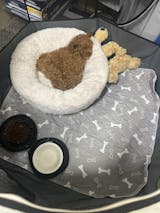Taming the Teething Tiger: Dealing with Puppy Nipping
Introduction
Puppy nipping is a common behavior that nearly all puppy parents face. Those tiny, sharp teeth seem to find their way to our fingers, toes, and just about anything else they can nibble on. Understanding why puppies nip and how to manage this behavior is essential for a harmonious relationship with your new furry family member. In this comprehensive guide, we'll explore the reasons behind puppy nipping, provide you with some effective strategies for managing and eventually curbing this behavior, and show how Dry Paws reusable puppy pads can play a significant role in your play areas.
Understanding the Why
Before diving into how to address puppy nipping, it's crucial to understand the 'why' behind this behavior. Nipping is entirely natural for puppies and serves various purposes in their development. These include exploring the world around them, communicating with their littermates, and engaging in play.
Teething Relief
One significant reason for puppy nipping is teething. Imagine experiencing the discomfort of tiny, sharp teeth pushing through your gums – it's not a pleasant sensation. As responsible puppy parents, we can help our pups through this challenging phase by providing suitable chew toys. These toys not only soothe their discomfort but also keep your fingers out of harm's way. Teething is a temporary phase, and providing your puppy with the right toys is a crucial part of their development.
To create an ideal play area for your puppy during teething, consider using Dry Paws reusable puppy pads. These pads are not only super absorbent but also highly durable. Placing them in your designated play area provides a soft, comfortable surface for your pup to play on while keeping accidents and messes under control. As your puppy explores their play area, they can safely chew and interact with their toys on the Dry Paws pad, reducing any mess and making clean-up a breeze.
Teaching Bite Inhibition
While puppy nipping is expected when they're young, it's vital to teach them bite inhibition as they grow. Bite inhibition refers to a puppy's ability to control the force of their bite. This is essential to ensure that playtime and interactions with humans remain safe and enjoyable.
Here's a simple approach to teach your pup bite inhibition:
-
Yelp Technique: When your puppy nips too hard, let out a high-pitched yelp. This mimics the response another puppy would have in a litter when bitten too hard. Your puppy will learn that their bite was too forceful.
-
Pause Play: Briefly pause playtime when your puppy bites too hard. This imitates the way puppies signal to each other in the litter that rough play leads to a pause. It's not a punishment but a way to convey that gentle play continues, while rough play results in a brief break.
Replace with Toys
You can't expect your puppy to stop nipping without offering an alternative. When your puppy nips you, gently redirect them to an appropriate chew toy. This not only saves your fingers but also reinforces what's okay to chew and what's not.
In your designated play area, ensure a variety of engaging toys to captivate your puppy's attention. By having a range of toys available, you can quickly redirect your puppy from nipping to playful interaction with their toys. Additionally, consider including some treat-dispensing toys that provide mental stimulation and a tasty reward, which can be particularly effective for puppies during their teething phase.
Maintaining a Consistent Schedule
Puppies thrive on routine. Maintaining a consistent schedule for feeding, playtime, and potty breaks can significantly reduce nipping behavior. When your puppy knows what to expect, they are less likely to become overly excited and engage in excessive nipping.
Dry Paws reusable puppy pads are an invaluable addition to your play area during this stage. You can use them as a designated potty area within the play zone. The super-absorbent nature of these pads ensures that any accidents are contained, making cleanup a breeze. Plus, they're machine-washable, making them a cost-effective and eco-friendly solution compared to disposable pads.
Seek Advice from the Community
Puppy parenting is an adventure filled with ups and downs, and sharing experiences and tips can be incredibly helpful. In our community, we've all been through the nipping phase, and we're here to support one another. If you've faced nipping challenges with your pup or have tried other strategies, share your experiences in the comments below. Your insights could be the solution another puppy parent is looking for.
Conclusion
In summary, puppy nipping is a normal behavior that can be managed and redirected with patience and consistency. Understanding the 'why' behind nipping, addressing teething discomfort, teaching bite inhibition, and redirecting to toys are key strategies to help you and your puppy through this phase.
By creating a well-structured play area for your puppy and including Dry Paws reusable puppy pads, you're not only promoting a clean and comfortable space but also reducing messes and simplifying cleanup. These pads are a great eco-friendly solution that can save you money while maintaining a fresh and dry play environment for your furry friend.
Together, we can tame the teething tiger and nurture our pups into well-behaved companions.
Remember, each puppy is unique, and it may take some time to see progress. Stay patient, consistent, and supportive in guiding your puppy towards good behavior.
Join the conversation by sharing your insights and questions below – let's support one another in this exciting journey of puppy parenting! 🐶🦷💬
















